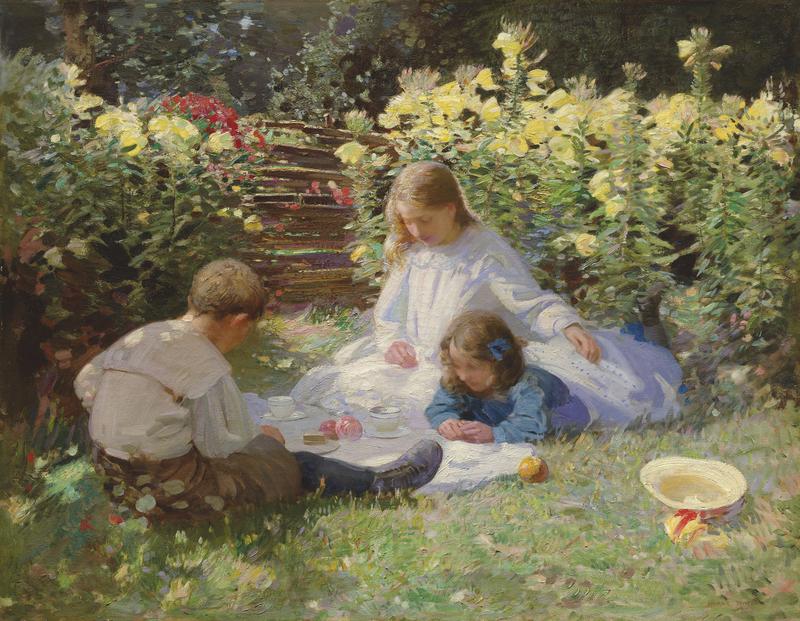The Garden Party

Primarily known for his landscape studies, The Garden Party is at the pinnacle of Watson’s rare ventures into figurative painting. In the late Edwardian summers, nature was seemingly bountiful, and women and children could often be seen enjoying the outdoors. Garden scenes provided Impressionist artists with ideal settings in which to develop their own interpretation of the modern concepts of naturalism and spontaneity, through new techniques using colour and light effects, and a greater sense of dynamism and atmosphere. Watson’s use of a modern, vibrant palette, bold and rapid brushstrokes, and a sense of rapidly capturing a moment in time, rather than a detailed devotion to narrative, sets The Garden Party apart from the depictions of children that his more traditional contemporaries were exhibiting. The painting provides a fascinating link between Edwardian subject matter and the modern techniques that had been developed by the Impressionists.
The Garden Party delivers a direct experience of light. It is the scene of an idealised view of childhood, set in a sun-dappled garden; a delightful evocation of warm, untroubled, summer days. The light-filled garden is abundant with flowers, the soft yellow of evening primrose is picked out with flecks of cerise, blue, lilac and lime green. The scene depicts a group of well-dressed, well-behaved children: one boy with his back towards the viewer, and two girls. The older girl sits demurely, with light shining on her hair, wearing a beautifully clean, white, lace-collared dress. She rests a protective hand on the back of the younger girl who lies on her front to her side. All the children have their eyes lowered, possibly in prayer as they say ‘Grace’ before their repast, consisting of apples and cake. Smart porcelain teacups are placed on a pristine white cloth. A straw hat lies in the foreground, upturned, as it if has been dropped in eagerness by the young girl who has let go her ball and flopped down, her hair slightly loosened from her blue bow, now swinging one raised foot, as if in impatient anticipation of the food on offer. The children are sheltered and secure, in their own ideal garden setting, shut off from the outside world.
During the Edwardian era, the consensus on the nature of childhood was reinforced, in the middle class especially, by an emphasis around the end of the century on the innocence and gaiety of children. Children should be cut off, as far as possible, from adult life and concerns which, of course, did not fit with working-class notions of childhood, education or with the economic needs of the poorer families. Nineteenth century educationalists, like Froebel and Montessori, were influential in the idea that children needed time and space to play as much as they needed food and shelter. Concern for children was focused on their health and healthy amusements. In a wider context, it was viewed as essential that a ‘fit and virile race’ was needed if Britain’s imperial supremacy was to be maintained against challenges from other powers. The imagery of childhood most available reinforces the notion of an abstract, idealised idea of the child. This illustrated a narrow social band of children and alternative representations of the working chid, the street child or the child in adult territory were to be viewed often as part of the presentation of a problem. Rural children could be portrayed in a similar idyll as, although poor, they were seen to be removed from the grime and dangers of an urban, industrial setting.
Watson studied at the Lambeth School of Art and at the Royal College of Art (1889-94) where he won numerous medals and was awarded a scholarship to Italy. During this time, he would have seen the works of the Impressionists exhibited regularly at Durand-Ruel’s gallery on Bond Street and would have been aware of how it was influencing the works of his contemporaries through exhibitions at the Royal Academy and the New English Art Club. Initially he painted in a conventional late-Victorian style but later developed into a plein air painter whose works exhibit great freshness and spontaneity, reminiscent of Clausen and Bastien-Lepage. From 1906 Watson’s Academy exhibits celebrate rural activities, illustrating figures recumbent beside streams, or wandering through woodland settings, using the theme as a metaphor for the profound relationship between nature and mankind.



